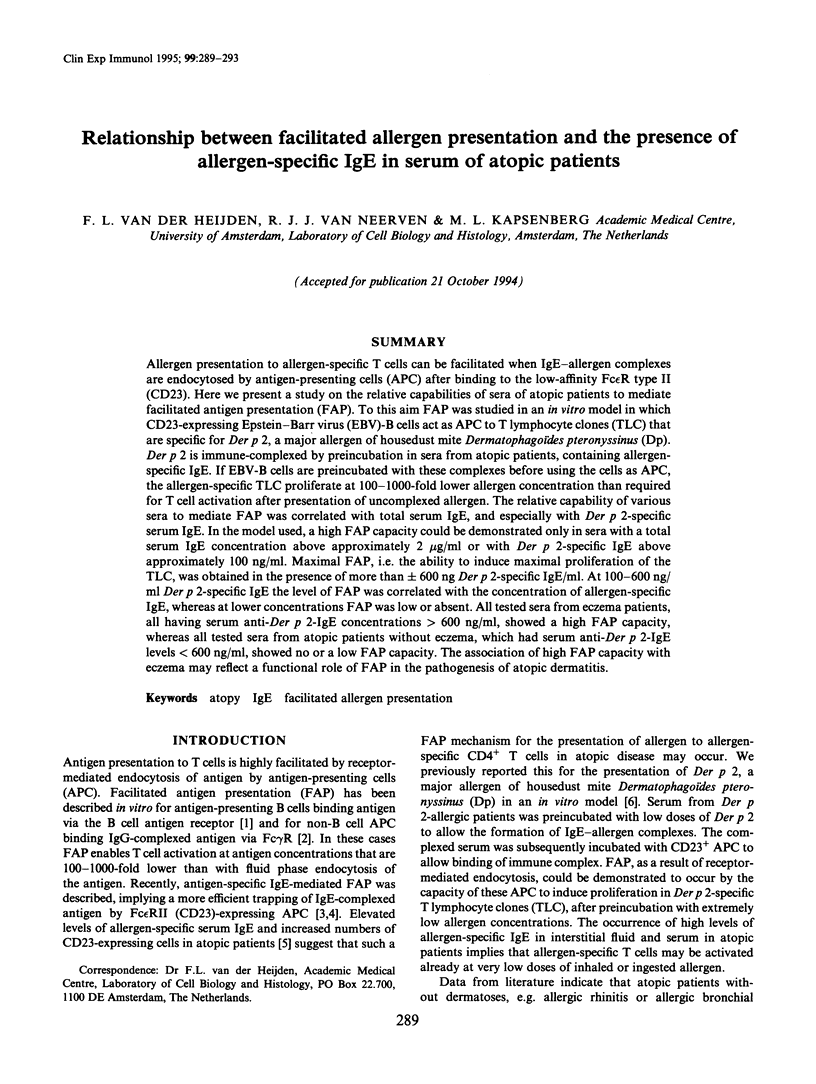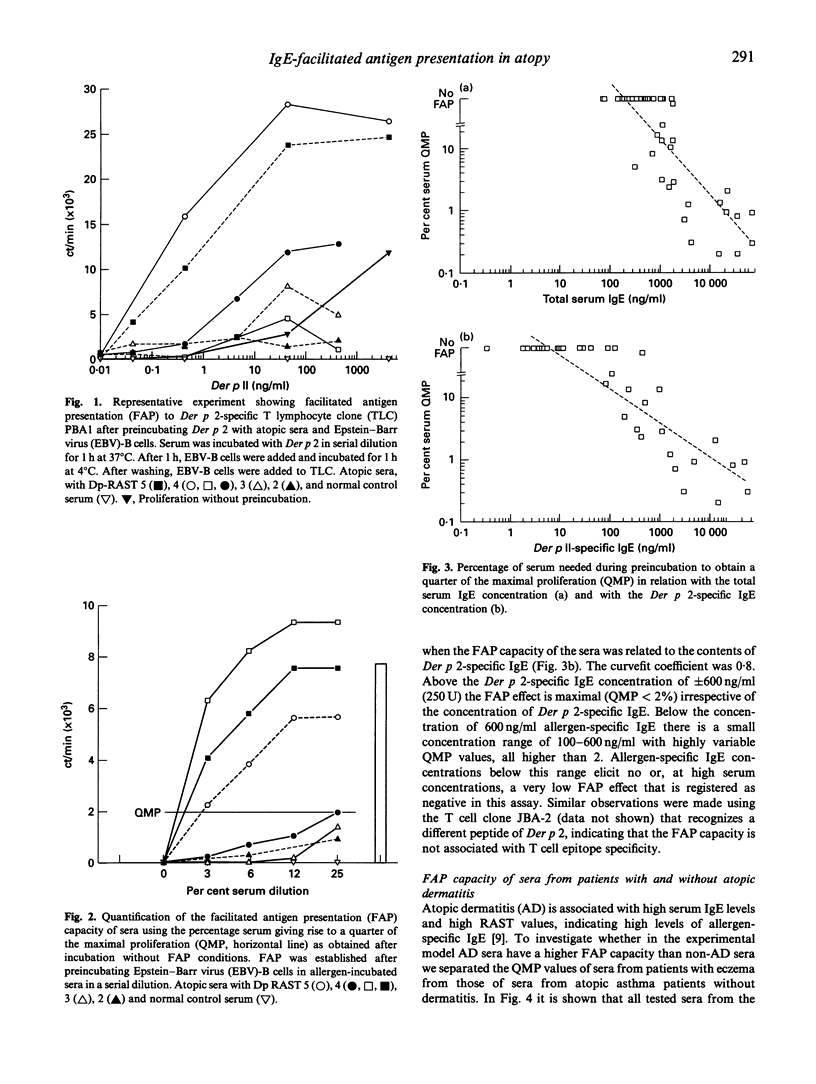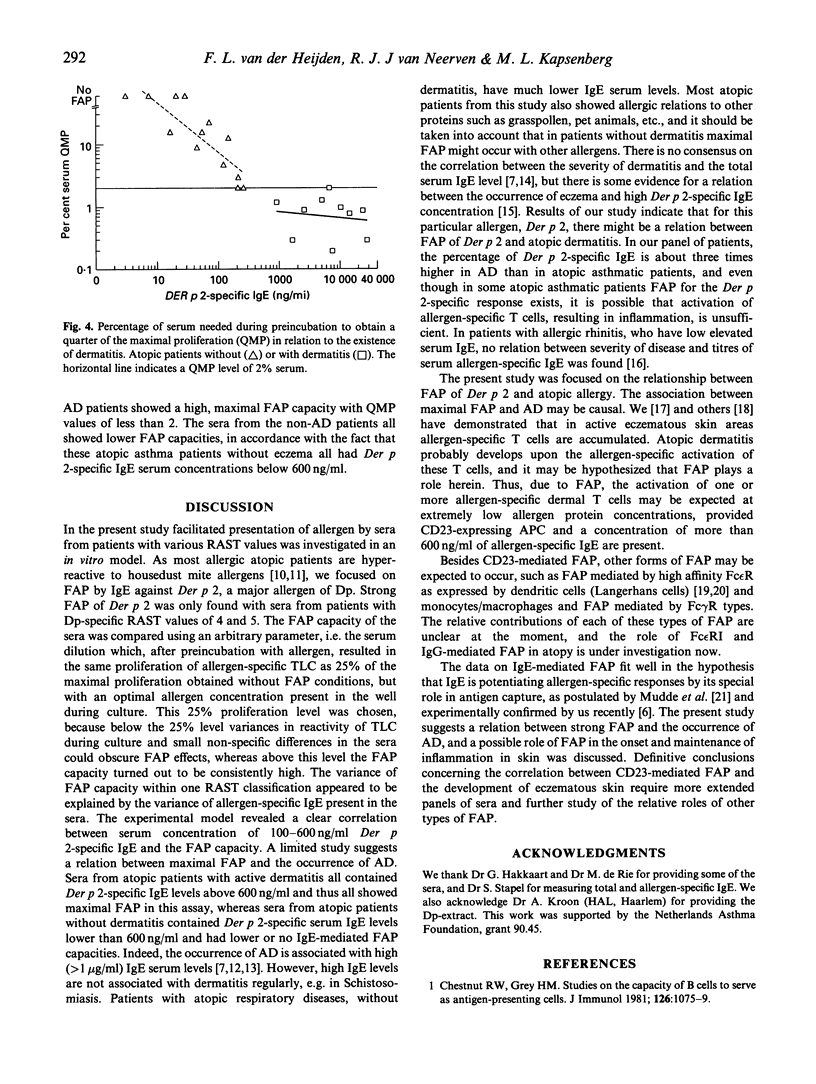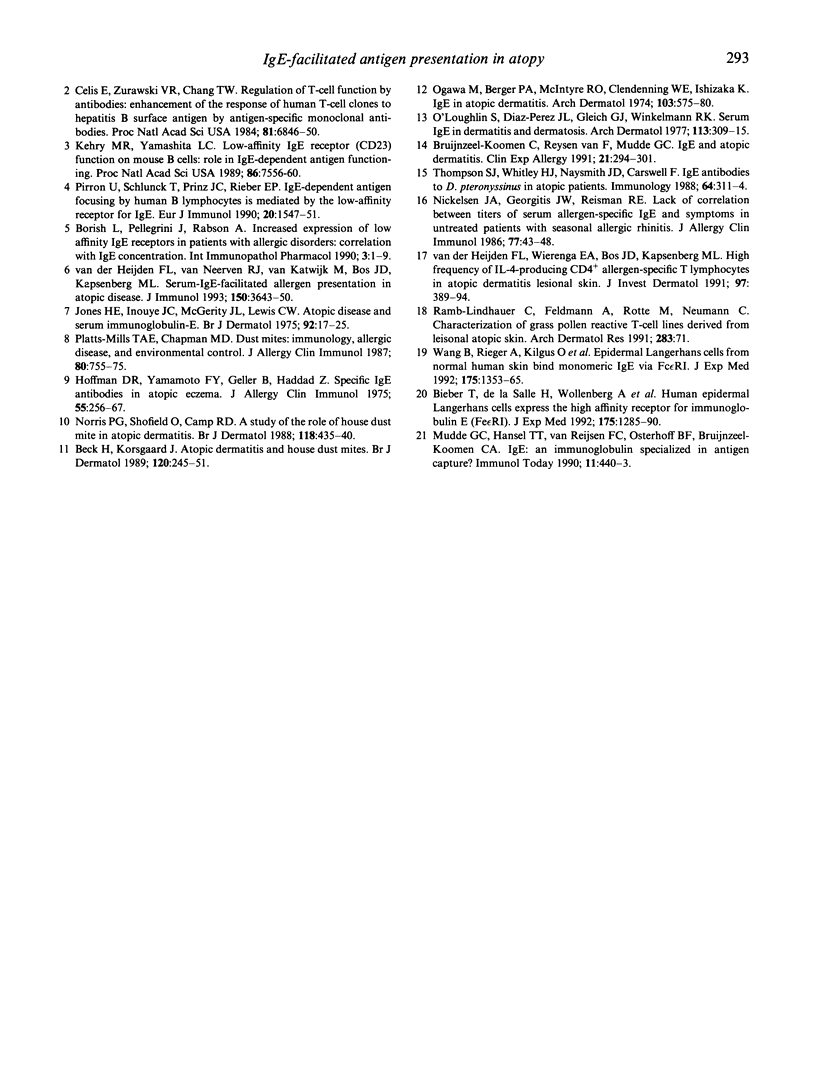Abstract
Allergen presentation to allergen-specific T cells can be facilitated when IgE-allergen complexes are endocytosed by antigen-presenting cells (APC) after binding to the low-affinity Fc epsilon R type II (CD23). Here we present a study on the relative capabilities of sera of atopic patients to mediate facilitated antigen presentation (FAP). To this aim FAP was studied in an in vitro model in which CD23-expressing Epstein-Barr virus (EBV)-B cells act as APC to T lymphocyte clones (TLC) that are specific for Der p 2, a major allergen of housedust mite Dermatophagoides pteronyssinus (Dp). Der p 2 is immune-complexed by preincubation in sera from atopic patients, containing allergen-specific IgE. If EBV-B cells are preincubated with these complexes before using the cells as APC, the allergen-specific TLC proliferate at 100-1000-fold lower allergen concentration than required for T cell activation after presentation of uncomplexed allergen. The relative capability of various sera to mediate FAP was correlated with total serum IgE, and especially with Der p 2-specific serum IgE. In the model used, a high FAP capacity could be demonstrated only in sera with a total serum IgE concentration above approximately 2 micrograms/ml or with Der p 2-specific IgE above approximately 100 ng/ml. Maximal FAP, i.e. the ability to induce maximal proliferation of the TLC, was obtained in the presence of more than +/- 600 ng Der p 2-specific IgE/ml. At 100-600 ng/ml Der p 2-specific IgE the level of FAP was correlated with the concentration of allergen-specific IgE, whereas at lower concentrations FAP was low or absent. All tested sera from eczema patients, all having serum anti-Der p 2-IgE concentrations > 600 ng/ml, showed a high FAP capacity, whereas all tested sera from atopic patients without eczema, which had serum anti-Der p 2-IgE levels < 600 ng/ml, showed no or a low FAP capacity. The association of high FAP capacity with eczema may reflect a functional role of FAP in the pathogenesis of atopic dermatitis.
Full text
PDF




Selected References
These references are in PubMed. This may not be the complete list of references from this article.
- Beck H. I., Korsgaard J. Atopic dermatitis and house dust mites. Br J Dermatol. 1989 Feb;120(2):245–251. doi: 10.1111/j.1365-2133.1989.tb07789.x. [DOI] [PubMed] [Google Scholar]
- Bieber T., de la Salle H., Wollenberg A., Hakimi J., Chizzonite R., Ring J., Hanau D., de la Salle C. Human epidermal Langerhans cells express the high affinity receptor for immunoglobulin E (Fc epsilon RI). J Exp Med. 1992 May 1;175(5):1285–1290. doi: 10.1084/jem.175.5.1285. [DOI] [PMC free article] [PubMed] [Google Scholar]
- Bruijnzeel-Koomen C., van Reysen F., Mudde G. C. IgE and atopic dermatitis. Clin Exp Allergy. 1991 Jan;21 (Suppl 1):294–301. doi: 10.1111/j.1365-2222.1991.tb01745.x. [DOI] [PubMed] [Google Scholar]
- Celis E., Zurawski V. R., Jr, Chang T. W. Regulation of T-cell function by antibodies: enhancement of the response of human T-cell clones to hepatitis B surface antigen by antigen-specific monoclonal antibodies. Proc Natl Acad Sci U S A. 1984 Nov;81(21):6846–6850. doi: 10.1073/pnas.81.21.6846. [DOI] [PMC free article] [PubMed] [Google Scholar]
- Chesnut R. W., Grey H. M. Studies on the capacity of B cells to serve as antigen-presenting cells. J Immunol. 1981 Mar;126(3):1075–1079. [PubMed] [Google Scholar]
- Jones H. E., Inouye J. C., McGerity J. L., Lewis C. W. Atopic disease and serum immunoglobulin-E. Br J Dermatol. 1975 Jan;92(1):17–25. doi: 10.1111/j.1365-2133.1975.tb03028.x. [DOI] [PubMed] [Google Scholar]
- Kehry M. R., Yamashita L. C. Low-affinity IgE receptor (CD23) function on mouse B cells: role in IgE-dependent antigen focusing. Proc Natl Acad Sci U S A. 1989 Oct;86(19):7556–7560. doi: 10.1073/pnas.86.19.7556. [DOI] [PMC free article] [PubMed] [Google Scholar]
- Mudde G. C., Hansel T. T., von Reijsen F. C., Osterhoff B. F., Bruijnzeel-Koomen C. A. IgE: an immunoglobulin specialized in antigen capture? Immunol Today. 1990 Dec;11(12):440–443. doi: 10.1016/0167-5699(90)90172-6. [DOI] [PubMed] [Google Scholar]
- Nickelsen J. A., Georgitis J. W., Reisman R. E. Lack of correlation between titers of serum allergen-specific IgE and symptoms in untreated patients with seasonal allergic rhinitis. J Allergy Clin Immunol. 1986 Jan;77(1 Pt 1):43–48. doi: 10.1016/0091-6749(86)90320-9. [DOI] [PubMed] [Google Scholar]
- Norris P. G., Schofield O., Camp R. D. A study of the role of house dust mite in atopic dermatitis. Br J Dermatol. 1988 Mar;118(3):435–440. doi: 10.1111/j.1365-2133.1988.tb02440.x. [DOI] [PubMed] [Google Scholar]
- O'Loughlin S., Diaz-Perez J. L., Gleich G. J., Winkelmann R. K. Serum IgE in dermatitis and dermatosis: an analysis of 497 cases. Arch Dermatol. 1977 Mar;113(3):309–315. [PubMed] [Google Scholar]
- Ogawa M., Berger P. A., McIntyre O. R., Clendenning W. E., Ishizaka K. IgE in atopic dermatitis. Arch Dermatol. 1971 Jun;103(6):575–580. [PubMed] [Google Scholar]
- Pirron U., Schlunck T., Prinz J. C., Rieber E. P. IgE-dependent antigen focusing by human B lymphocytes is mediated by the low-affinity receptor for IgE. Eur J Immunol. 1990 Jul;20(7):1547–1551. doi: 10.1002/eji.1830200721. [DOI] [PubMed] [Google Scholar]
- Platts-Mills T. A., Chapman M. D. Dust mites: immunology, allergic disease, and environmental control. J Allergy Clin Immunol. 1987 Dec;80(6):755–775. doi: 10.1016/s0091-6749(87)80261-0. [DOI] [PubMed] [Google Scholar]
- Ramb-Lindhauer C., Feldmann A., Rotte M., Neumann C. Characterization of grass pollen reactive T-cell lines derived from lesional atopic skin. Arch Dermatol Res. 1991;283(2):71–76. doi: 10.1007/BF00371611. [DOI] [PubMed] [Google Scholar]
- Thompson S. J., Whitley H. J., Naysmith J. D., Carswell F. IgE antibodies to D. pteronyssinus in atopic patients. Immunology. 1988 Jun;64(2):311–314. [PMC free article] [PubMed] [Google Scholar]
- Wang B., Rieger A., Kilgus O., Ochiai K., Maurer D., Födinger D., Kinet J. P., Stingl G. Epidermal Langerhans cells from normal human skin bind monomeric IgE via Fc epsilon RI. J Exp Med. 1992 May 1;175(5):1353–1365. doi: 10.1084/jem.175.5.1353. [DOI] [PMC free article] [PubMed] [Google Scholar]
- van der Heijden F. L., Joost van Neerven R. J., van Katwijk M., Bos J. D., Kapsenberg M. L. Serum-IgE-facilitated allergen presentation in atopic disease. J Immunol. 1993 Apr 15;150(8 Pt 1):3643–3650. [PubMed] [Google Scholar]
- van der Heijden F. L., Wierenga E. A., Bos J. D., Kapsenberg M. L. High frequency of IL-4-producing CD4+ allergen-specific T lymphocytes in atopic dermatitis lesional skin. J Invest Dermatol. 1991 Sep;97(3):389–394. doi: 10.1111/1523-1747.ep12480966. [DOI] [PubMed] [Google Scholar]


